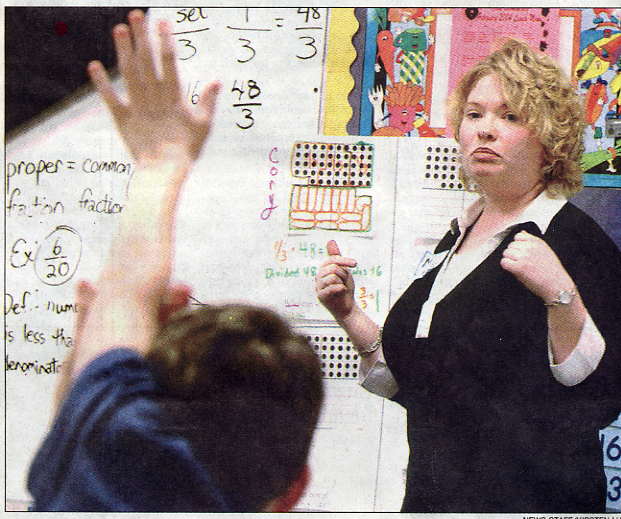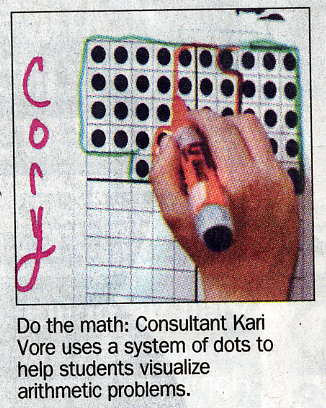
News Staff Photo/Kirsten Luce
Money raised from selling
cookie dough paid for consultant Kari Vore to train math teachers at Clay
Elementary School.
New Ways to Skin Math

News Staff Photo/Kirsten Luce
Money raised from selling
cookie dough paid for consultant Kari Vore to train math teachers at Clay
Elementary School.
New Ways to Skin Math
| Instructors learn visual techniques aid numerical
literacy
by Vicki McClure, News Staff Writer Armed with a bevy of dots and a grid, Kari Vore easily explained to Clay Elementary children last week how to solve math problems such as calculating 1/3 of 48 and determining the sale price of a discounted puzzle. The goal was to help children visualize what was being asked of them. Math is essentially a language the Wyoming teaching consultant said. Children must understand the concepts underlying the numbers and symbols, she said, much like they learn that words can represent people, actions and objects when they begin to read. The methods Vore demonstrated to Clay teachers came from a program called
Number Literacy, first shown to Jefferson County educators last summer.
Clay Principal Ellen Andrews said she and her faculty hope teaching math
more visually will bet-
Andrews spent money raised form cookie dough sales to bring Vore to Clay so that the staff would be fully trained. Three other Jefferson County elementary schools--Chalkville, Hillview, and Brighton--boast similar levels. Another workshop is to be offered to all Jefferson County educators for a week this summer. The more tools we can put in teachers' hands, the more effective they will be," said Mara Jambor, the Jefferson County supervisor for elementary reading, math and social studies instruction. "Children learn how to do things in different ways. One size never fits all." Vore placed a grid of 100 squares on the white board of fifth-grade teacher Carol Hobby. In 48 of the squares lay a dot. She then asked students how they would determine what 1/3 of 48 equaled. Cory Parkes quickly saw the solution and walked to the front of the class. |

He circled three groups of dots, each containing 16, to show 48 divided by three equals 16. When Vore asked if others understood how Cory had arrived at his answer, many said they did not. So she walked them through the notion of sets. She circled a row on the grid and reminded them each contained 10 squares. She also outlined the grid to emphasize a collection of 10 rows. Ten groups of 10 squares equals 100, she said, so the grid is a set of 100. Then she likened the set of squares to the smaller one within the grid composed of dots. What the problem above is really asking.she explained, is how many sets of three, or 1/3, fit into the larger set of 48. She had them circle groups of three dots on their own sheets and emphasized
that they had seen two ways
"Was Cory wrong?" Vore asked. No, said the children. She added: "He just said it in another way." |